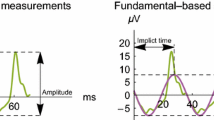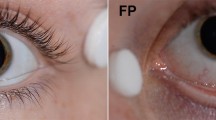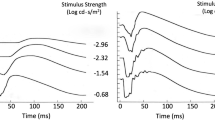Abstract
The purpose of this study was to examine whether the use of the DTL fiber electrode yields stable and reproducible electroretinographic recordings. To do so, luminance response function, derived from dark-adapted electroretinograms, was obtained from both eyes of 10 normal subjects at two recording sessions spaced by 7–14 days. The data thus generated was used to calculate Naka-RushtonV max andk parameters and values obtained at the two recording sessions were compared. Our results showed that there was no significant difference in the values ofV max andk calculated from the data generated at the two recording sessions. The above clearly demonstrate that the use of the DTL fiber electrode does not jeopardize, in any way, the stability and reproducibility of ERG responses.
Similar content being viewed by others
References
Marmor MF, Zrenner E. Standard for clinical electroretinography (1994 update). Doc Ophthalmol 1995; 89: 199–210.
Dawson WW, Trick GL, Litzkow CA. Improved electrode for electroretinography. Invest Ophthalmol Vis Sci 1979; 18: 988–91.
Lachapelle P, Benoit J, Little JM, Lachapelle B. Recording the oscillatory potentials with the DTL electrode. Doc Ophthalmol 1993; 83: 119–30.
Lachapelle P, Benoit J, Blain L, Guité P, Roy MS. The oscillatory potentials in response to stimuli of photopic intensities delivered in dark-adaptation are explanation for the conditioning flash effect. Vision Res 1990; 30: 503–13.
Peachey NS, Alexander KR, Fishman GA. Rod and cone system contributions to oscillatory potentials: an explanation for the conditioning flash effect. Vision Res 198; 27: 859–66.
Birch DG, Berson EL, Sandberg MA. Diurnal rhythm in the human rod. ERG. Invest Ophthalmol Vis Sci 1984; 25: 236–8.
Arden GB, Carter RM, Hogg CR, Powell CR, Ernst WJK, Clover GMM, Lyness AL, Quilzlan MP. A modified ERG technique and the results obtained in X-linked retinitis pigmentosa. Br J Ophthalmol 1983; 67: 419–30.
Aylward GW. A simple method of fitting the Naka-Rushton equation. Clin Vision Sci 1989; 4: 275–7.
Evans LS, Peachey NS, Marchese AL. Comparison of three methods of estimating the parameters of the Naka-Rushton equation. Doc Ophthalmol 1993; 84: 19–30.
Hood DC, Birch DG. A computational model of the amplitude and implicit time of the b-wave of the human ERG. Vis Neurosci 1992; 8: 107–26. 11.
Johnson MA, Marcus S, Elman MJ, McPhee TJ. Neovascularization in central retinal vein occlusion: electroretinographic findings. Arch Ophthalmol 1988; 106: 348–52.
Wu L, Massof RW, Starr SJ. Computer assisted analysis of clinical electroretinographic intensity-response functions. Doc Ophthalmol Proc Ser 1983; 37: 231–9.
Birch DG, Fish GE. Rod ERGs in retinitis pigmentosa and cone-rod degeneration. Invest Ophthalmol Vis Sci 1987; 28: 140–50.
Fleiss JL. The design and analysis of clinical experiments. New York, John Wiley & Sons, 1985: 1–14.
Prager TC, Saad N, Schweiter FC, Garcia CA, Arden GB. Electrode comparison in pattern electroretinography. Invest Ophthalmol Vis Sci 1992; 33: 390–4.
Hennessy MP, Vaegan. Amplitude scaling relationships of Burian-Allen, gold foil and Dawson, Trick and Litzkow electrodes. Doc Ophthalmol 1995; 89: 235–48.
Doslak MJ, Plonsey R, Thomas CW. The effects of variations of the conducting media inhomogeneities on the electroretinogram. IEEE Trans Biomed. Eng 1980: 27: 88–94.
Cringle SJ, Alder VA, Brown MJ, Yu DY. Effect of scleral recording location on ERG amplitude. Curr Eye Res 1986; 5: 959–65.
Author information
Authors and Affiliations
Rights and permissions
About this article
Cite this article
Hébert, M., Lachapelle, P. & Dumont, M. Reproducibility of electroretinograms recorded with DTL electrodes. Doc Ophthalmol 91, 333–342 (1995). https://doi.org/10.1007/BF01214651
Accepted:
Issue Date:
DOI: https://doi.org/10.1007/BF01214651




